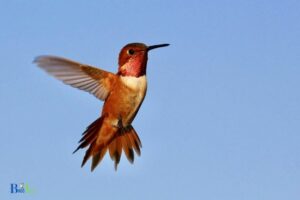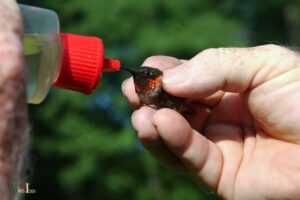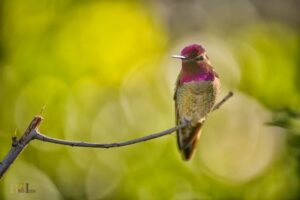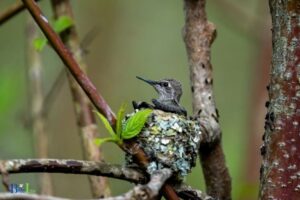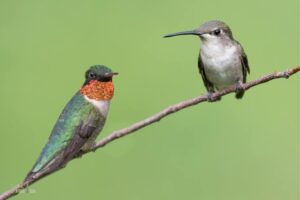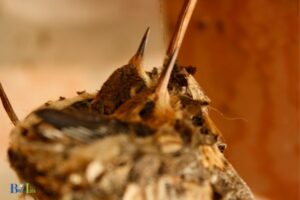How to Describe a Hummingbird: Beginners Guide!
A hummingbird is a small, vibrantly colored bird known for its rapid wing movements, ability to hover, and long, slender bill specialized for feeding on nectar.
Hummingbirds are members of the family Trochilidae, comprising over 300 species. They are native to the Americas, primarily inhabiting tropical and subtropical regions.
These birds are highly coveted by birdwatchers and nature enthusiasts due to their unique characteristics and stunning appearance.
Hummingbirds are truly remarkable creatures, possessing a unique combination of adaptations that set them apart from other bird species.
From their dazzling iridescent feathers to their unparalleled ability to hover in mid-air, these tiny birds have captivated the hearts of nature lovers around the world.
11 Aspects of a Hummingbird
| Aspect | Description |
| Size | 3 to 5 inches in length |
| Weight | 0.07 to 0.2 ounces |
| Wingspan | 4 to 8 inches |
| Coloration | Iridescent, bright & varied colors |
| Beak | Long, thin, and straight or curved |
| Flight pattern | Hovering, fast, agile, and acrobatic |
| Feeding habits | Nectar, small insects, and spiders |
| Nesting habits | Small, cup-shaped nests |
| Mating habits | Aerial displays & vocalizations |
| Migration | Some species migrate long distances |
| Lifespan | 3 to 5 years in the wild |
Key Takeaway
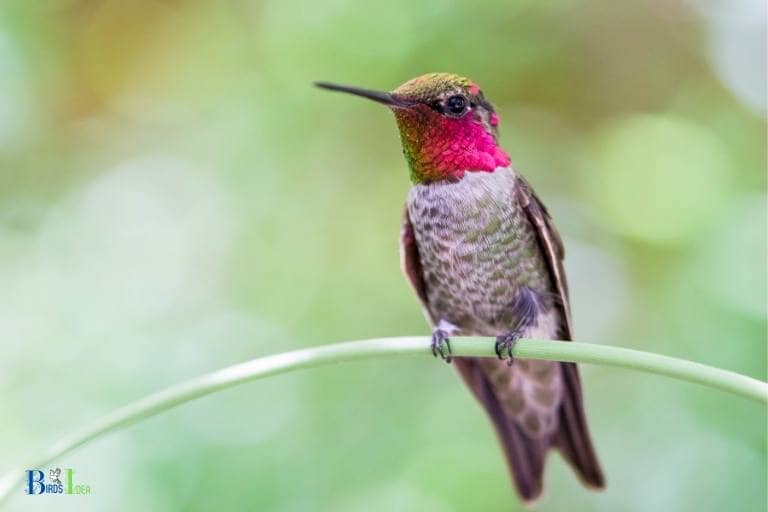
Five Facts About: Hummingbirds
The Beauty And Complexity Of Hummingbirds
Beauty And Complexity Of Hummingbirds
Hummingbirds are one of the most fascinating creatures in the animal kingdom. Their unique characteristics and stunning beauty often leave people in awe.
Here are some key points to help understand the beauty and complexity of hummingbirds:
Fast, Agile And Tireless Fliers:
- Hummingbirds possess a high metabolism and are capable of flapping their wings at a rate of approximately 80 beats per second!
- This allows them to hover mid-air, fly up, down, backward, and even upside down!
Colorful Plumage:
- Hummingbirds have striking and iridescent plumage, often reflecting a rainbow of colors depending on the light.
- They also possess a unique feature – the gorget, which is a bright, colored patch found on the throat of male hummingbirds.
Tiny But Mighty:
- Despite their small size, hummingbirds have larger hearts than most birds in comparison to their body size.
- This allows them to pump more oxygen to their muscles while in flight and remain tireless for long periods.
Nectar Feeders:
- Hummingbirds are mostly known for their love of nectar, which they get from various flowering plants.
- They possess an impressively long and narrow bill that allows them to reach deep into flowers and drink the sweet nectar.
Master Of Territorial Battles:
- Although they are small, hummingbirds are feisty and aggressive when it comes to defending their territory.
- They use their speed and agility to chase rival birds away, and males often use their brightly colored plumage to display dominance.
A Worthy Pollinator:
- As hummingbirds fly from flower to flower collecting nectar, they pick up pollen on their beaks and feathers, transferring it to other flowers.
- This helps to pollinate the flowers, making hummingbirds ecologically essential.
Hummingbirds truly are one of nature’s most magnificent creations, and appreciating their extraordinary beauty and complexity is something that never gets old.
The Anatomy Of Hummingbirds
Hummingbirds are one of nature’s most fascinating creatures. Known for their small size and incredible speed, these birds are a wonder to behold.
In this section, we will discuss the key aspects of the anatomy of hummingbirds, exploring how their physical characteristics help them to survive in the wild.
Discuss The Physical Characteristics Of Hummingbirds
Hummingbirds are small birds that are typically no more than 10cm in length, with a wingspan of around 13cm. However, what they lack in size, they make up for in stunning and vibrant plumage.
Here are some of the key physical characteristics of hummingbirds in detail.
- Vivid colors: Hummingbirds have iridescent feathers that reflect light in a way that creates beautiful, shimmering colors. These feathers are not just for show; they help to attract mates and defend territory.
- Long beaks: The long, slender beak of a hummingbird is perfectly designed to reach the nectar deep within flowers. The tip of the beak is even split in two, allowing the bird to lap up nectar more effectively.
- Wings: Hummingbirds can flap their wings at a rate of up to 80 times per second, making them the only bird that can hover in mid-air. Their wings also allow them to fly backwards and forwards and even upside down.
- Metabolism: Despite their small size, hummingbirds have an incredible metabolism that allows them to consume twice their body weight in nectar every day. This high metabolism is essential to fuel their demanding energy needs, which is why they spend the majority of their time feeding.
The anatomy of a hummingbird is perfectly adapted to their unique lifestyle. From their vivid colors to their incredible metabolism, these birds are a true marvel of nature.
Hummingbird Habitat And Distribution
Hummingbirds are distributed throughout the americas, from alaska to tierra del fuego. They are known for their love of nectar, which is why they can be found in environments that have an abundance of flowers.
Their migration patterns also vary depending on their habitat.
Natural Habitats Of Hummingbirds
Hummingbirds can be found in a variety of habitats, including:
- Forests
- Grasslands
- Deserts
- Wetlands
- Mountains
Their preferred habitat is an area with a lot of flowers that produces a lot of nectar, which is their primary source of food.
They are also attracted to brightly colored flowers, particularly red and orange ones, and flowers that have a unique shape that allows them to access the nectar more easily.
Migratory Patterns Of Hummingbirds
Hummingbirds are known for their impressive migratory patterns. While some species, such as the anna’s hummingbird and costa’s hummingbird, are non-migratory and can be found in their habitats throughout the year, other species are migratory.
Some of these migratory species travel thousands of miles each year.
Hummingbirds are able to navigate thanks to their excellent eyesight and memory. They are also able to detect changes in the earth’s magnetic field, which helps them navigate during their long journeys.
Physical Characteristics Of Hummingbirds
The various environments where hummingbirds can be found have influenced their physical characteristics.
Some of the physical adaptations that hummingbirds have developed over time include:
- Long, thin beaks that allow them to access the nectar from flowers
- Lightweight bodies that enable them to hover in place and fly quickly
- Rapid heart rates that allow them to digest nectar quickly and fly efficiently
- Large wings that allow them to fly in many different directions, including backwards
Overall, hummingbirds are remarkable creatures that have developed unique physical characteristics and migratory patterns to survive and thrive in a variety of environments.
Feeding Habits Of Hummingbirds
Hummingbirds are fascinating creatures to watch as they feed. They have interesting and unique feeding habits that set them apart from other birds.
Let’s take a closer look at how they feed and what makes them so special.
How Hummingbirds Use Their Long Beaks To Extract Nectar From Flowers
Hummingbirds have long, thin beaks that allow them to extract nectar from deep within flowers.
Here are some key points about their feeding habits:
- Hummingbirds use their long beaks to reach deep into flowers and extract nectar.
- They are equipped with tongues that can extend well beyond their beaks to reach the nectar.
- Hummingbirds feed primarily on flower nectar and tree sap, but they also eat insects for protein.
The Hummingbird’S Ability To Perceive Colors And Find The Flowers They Need To Feed
Hummingbirds have a remarkable ability to perceive colors, which helps them find the flowers they need to feed.
Here are some key points about their feeding habits:
- Hummingbirds can see colors that are invisible to humans, including ultraviolet light.
- They use their keen eyesight to find brightly colored flowers with high nectar content.
- Some species of hummingbirds have longer bills and tongues that allow them to feed from more specialized flowers that other birds can’t reach.
Hummingbirds are amazing creatures with unique and interesting feeding habits. Their ability to extract nectar using their long beaks and perceive colors to find the flowers they need to feed are just a few of the things that make them special.
Watching these tiny birds in action is a true delight for any nature lover.
Social Life Of Hummingbirds
Hummingbirds are among the most fascinating creatures on the planet due to their unique shape, vibrant colors, and swift movements. With over 300 species, the social behavior of hummingbirds is as diverse as it is interesting.
We’re going to explore the fascinating social life of hummingbirds under the following h3 headings:
Flocking Patterns Among Hummingbirds
Hummingbirds are solitary birds, but they occasionally come together in large groups. Understanding why these birds flock together may shed light on some of their social behaviors.
Here are some of the reasons why hummingbirds flock:
- To mate: Male hummingbirds gather around a female bird to compete for her attention and to mate.
- To defend food sources: When food is scarce, hummingbirds come together to defend their territory.
- To roost: Some species of hummingbirds roost together in large groups to keep warm during the night.
Courtship Behaviors
Hummingbirds have elaborate mating rituals that involve courtship displays, songs, and physical displays.
Here are some of the courtship behaviors exhibited by hummingbirds:
- Diving displays: Male hummingbirds will dive toward a female bird in a display of strength and agility.
- Tail feather displays: Many species of hummingbirds have elaborate tail feathers that are used to attract females during courtship.
- Vocalizations: Hummingbirds make high-pitched chirping sounds to communicate with each other and to attract mates.
How Their Unique Shape And Color Make Them Charming And Interesting To Observe
Hummingbirds are some of the most visually striking birds due to their vibrant colors and intricate markings.
Here are some of the features that make hummingbirds so charming:
- Shimmering feathers: The feathers of hummingbirds are iridescent, which means that they change color depending on the angle of light.
- Long, slender beaks: Their long, thin beaks have a unique structure that allows them to reach deep into flowers to extract nectar.
- Fast-paced movements: Hummingbirds have the ability to fly forwards, backward, and even upside-down due to their powerful wings.
Overall, the social life of hummingbirds is incredibly diverse and fascinating. From their courtship behaviors to their unique shape and color, there’s no shortage of interesting things to observe about these incredible creatures.
Identifying Different Species Of Hummingbirds
How To Identify Different Species Of Hummingbirds
Hummingbirds are among the most fascinating birds on the planet, with a diverse range of colors and unique wing patterns. However, it can be difficult to identify which species of hummingbird you are observing.
Here are some tips to help you analyze and classify hummingbirds based on their colors, wingspan, and habitats:
Colors
Hummingbirds come in a range of colors, from iridescent green to fiery red and orange hues.
To identify a hummingbird’s species based on their colors, look for these key characteristics:
- Throat color: Many hummingbirds have brightly colored throats, which can range from blue, green, red, purple, or even black.
- Head and body color: Observe the hummingbird’s head and body for any distinctive colors or patterns, such as stripes or spots.
- Tail color: Finally, try to identify the color of the hummingbird’s tail feathers. Some species have uniquely shaped tails, which can be used as a key identifier.
Wingspan
In addition to their vibrant colors, hummingbirds also have distinctive wing patterns that can help you classify their species.
Here are some key characteristics to look for when analyzing a hummingbird’s wings:
- Wing shape: Different hummingbird species have different wing shapes, with some having broad, rounded wings and others having long, pointed wings.
- Wing color: Observe the color of the hummingbird’s wings to identify any unique patterns or hues.
- Wingbeat: Finally, try to observe the hummingbird’s wingbeat, which can be rapid or slow depending on the species.
Habitat
Hummingbirds have adapted to a range of different habitats, from the cloud forests of south america to the deserts of the united states.
To identify a hummingbird’s species based on their habitat, look for these key characteristics:
- Altitude: Different hummingbird species live at different elevations, so observe the bird’s location to identify potential candidates.
- Vegetation: Hummingbirds often live near flowering plants, so observe the surrounding vegetation for any distinctive features.
- Geography: Finally, consider the geographic location of the hummingbird, as certain species are only found in specific regions of the world.
By following these tips, you can easily identify a hummingbird’s species based on their colors, wingspan, and habitat. So next time you spot one of these captivating birds, you’ll know exactly which species you’re observing!.
Together, we can make a significant difference in hummingbird conservation efforts.
Hummingbird Gardens In Your Backyard
Are you a nature lover who wants to attract hummingbirds to your backyard? If yes, then you’re in for a treat! With a few simple steps, you can create a hummingbird garden in your backyard.
Here are some easy ways to attract hummingbirds to your yard:
Plant The Right Flowers
Hummingbirds are attracted to brightly colored, tube-shaped flowers that are rich in nectar.
Some of the best flowers to plant in your garden for hummingbirds are:
- Bee balm: It has bright, showy blooms that come in shades of red, pink, and purple.
- Cardinal flower: It produces vibrant red flowers with trumpet-shaped blooms.
- Columbine: It has unique, bell-shaped flowers that come in an array of colors.
- Salvias: It produces long, tubular flowers that come in shades of red, purple, and pink.
Use Feeders
Hummingbird feeders are an excellent way to attract these beautiful birds to your backyard. Fill the feeder with a simple syrup mixture made from four parts water and one part granulated sugar.
You can also purchase ready-to-use nectar at your local pet store.
Regularly change the nectar and clean the feeder to prevent bacteria growth.
Provide Suitable Habitat
Hummingbirds also need a suitable habitat to thrive. They prefer open spaces with plenty of sunlight and natural cover for nesting and perching.
Here are some tips to provide a suitable habitat:
- Hang a few bird feeders and birdhouses.
- Plant trees and shrubs in your yard to provide natural cover.
- Create a water source like a bird bath or a shallow pool.
Attracting hummingbirds to your garden is an excellent way to connect with nature and appreciate its beauty. So, what are you waiting for? Start creating your hummingbird garden today and enjoy the sight of these fascinating birds in your backyard!
FAQ Of How To Describe A Hummingbird
What Is A Hummingbird?
What Does A Hummingbird Eat?
What Is The Average Lifespan Of A Hummingbird?
What Are Some Interesting Facts About Hummingbirds?
How Can I Attract Hummingbirds To My Garden?
Conclusion
After learning the art of describing a hummingbird, you can now proudly share your observations with the world. By using beautiful imagery, strong adjectives, and vivid details, you can paint a picture that captures the essence of this amazing creature.
Remember to use specific terms like iridescent, hovering, and agile, to create a more tangible image for your audience.
Lastly, don’t forget the importance of understanding context – a hummingbird in flight is much different from a hummingbird perched on a branch.
By keeping these tips in mind, you can become an expert at describing hummingbirds and bring their beauty to life through your words. Give it a try and watch as your descriptions come to life.

